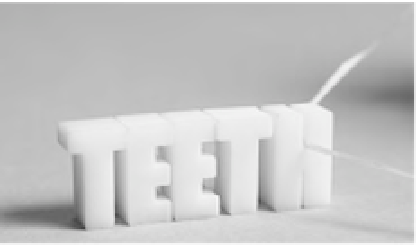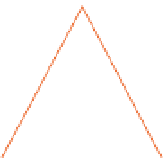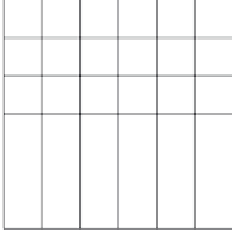Graphics Reference
In-Depth Information
9-17
In this image the
camera was positioned
high and to the left of
the typography, showing
the three-dimensional
letterforms as part of the
landscape. (Designer:
Tiffany Small)
Camera angle.
Another technique that allows the type to remain
in a fixed position is altering the “camera” angle. While in most cases
designers are not operating an actual camera to film an animation,
this technique can be achieved through software. The perspective
of the viewer is changed by moving the camera and giving different
impressions. For example, dramatic angles give a stronger illusion
of three-dimensional space, making typography part of the virtual
landscape (Fig.
9-17
). A camera angle can also affect how a subject
is perceived. A high-angle shot can make the subject seem small or
weak, while a low-angle shot can make the subject seem important or
powerful.
Camera movement.
In a motion sequence, the subject may
remain fixed, while the camera movement changes the viewer's
perspective. Some terms used in motion design are borrowed from
film and include
panning
,
tilting
,
tracking
, and
zooming
. In a panning
shot, the type or subject is stationary and the camera moves from left
to right. In a tilting shot, the camera moves up and down. In a tracking
shot, the camera moves forward or backward through space, or
parallel to the action. Zooming allows the camera to get closer to the
subject over time (Fig.
9-18
).
9-18
In these examples, the subject, the letter
A
,
is stationary, while the camera moves around it,
panning, tilting, tracking, and zooming.
The frame and space
Designers in all media must consider the edge of a composition and
how the type enters, exits, or is contained by the frame. Additionally,
if letters, words, or images are moving, the frame acts as a constant
reference point and becomes more important to how the viewer
follows the animation and reads the message.
Three primary axes
. A grid helps visually organize and group
words or establish alignments. If viewers perceive there is visual
organization, it can help them focus on the changes to the type over
time. When thinking about how type can move or change, we start by
noting the position at which it enters a frame. Position is noted on a
grid that locates points on a two-dimensional plane with a horizontal
x
-axis and a vertical
y
-axis (Fig.
9-19
). In addition, principles of three-
dimensional space—point, line, plane, volume, and perspective—are
important to time-based media because shapes have behaviors which
are more apparent in three-dimensional space. A transverse
z
-axis
locates a point in space, either in front of or behind the picture plane
(Fig.
9-20
). Once a starting position is identified, a designer plots a
trajectory for the type and determines how it will move and change in
the frame.
Depth of field,
. When working in three dimensions, principles
of visual perception are used to create natural-looking movement.
One principle, depth of field, states that objects that are farther away
are smaller, lighter, and less in focus. Objects in the foreground are
larger, darker, and sharper. Similarly, objects in the foreground move
faster because they are larger, while images farther away move slower
because they are smaller (Fig.
9-21
).
9-19
9-20



























































